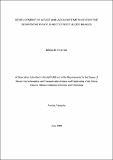| dc.contributor.author | Mwawado, Rehema H. | |
| dc.date.accessioned | 2020-09-18T05:47:42Z | |
| dc.date.available | 2020-09-18T05:47:42Z | |
| dc.date.issued | 2020-06 | |
| dc.identifier.uri | https://doi.org/10.58694/20.500.12479/913 | |
| dc.description | A Dissertation Submitted in Partial Fulfilment of the Requirements for the Degree of
Master’s in Information and Communication Science and Engineering of the Nelson
Mandela African Institution of Science and Technology | en_US |
| dc.description.abstract | Globally, Diabetic Foot Ulcers (DFUs) are among the major sources of morbidity and death
among people diagnosed with diabetes. Diabetic foot ulcers are the leading diabetes-related
complications that result in non-traumatic lower-limb amputations among these patients. Being
a serious health concern, DFUs present a significant therapeutic challenge to specialists,
particularly in countries with limited health resources and where the vast majority of patients
are admitted to healthcare facilities when the ulcers have fully advanced.
Clinical practices currently employed to assess and treat DFU are mostly based on the vigilance
of both the patient and clinician. These practices have been proved to experience major
limitations which include less accurate assessment methods, time-consuming diagnostic
procedures, and relatively high treatment costs. Digital image processing is thus a potential
solution to address issues of the inaccuracy of visual assessment as well as minimizing
consecutive patient visits to the clinics.
Image processing techniques for ulcer assessment have thus been a center of study in various
works of literature. In the available works of literature, these methods include measuring the
ulcer area as well as using a medical digital photography scheme. The most notable drawbacks
of such approaches include system complexity, complex-exhaustive training phases, and high
computational cost.
Inspired by the weaknesses of the existing techniques, this study proposes a segmentation
method that incorporates a hybrid diffusion-steered functional derived from the Total variation
and the Perona-Malik diffusivities, which have been reported that they can effectively capture
semantic features in images. Empirical results from the experiments that were carried out in
the MATLAB environment show that the proposed method generates clearer segmented
outputs with higher perceptual and objective qualities. More importantly, the proposed method
offers lower computational times—an advantage that gives more insights into the possible
application of the method in time-sensitive tasks. | en_US |
| dc.language.iso | en | en_US |
| dc.publisher | NM-AIST | en_US |
| dc.rights | Attribution-NonCommercial-ShareAlike 4.0 International | * |
| dc.rights.uri | http://creativecommons.org/licenses/by-nc-sa/4.0/ | * |
| dc.subject | Research Subject Categories::TECHNOLOGY | en_US |
| dc.title | Development of a fast and accurate method for the segmentation of diabetic foot ulcer images | en_US |
| dc.type | Thesis | en_US |


